Here is everything you need to know about baby-led weaning with banana, from a pediatric registered dietitian. Whether you’re doing baby-led weaning, spoon-feeding, or a combination, this post will walk you through, step-by-step how to introduce bananas to your baby.
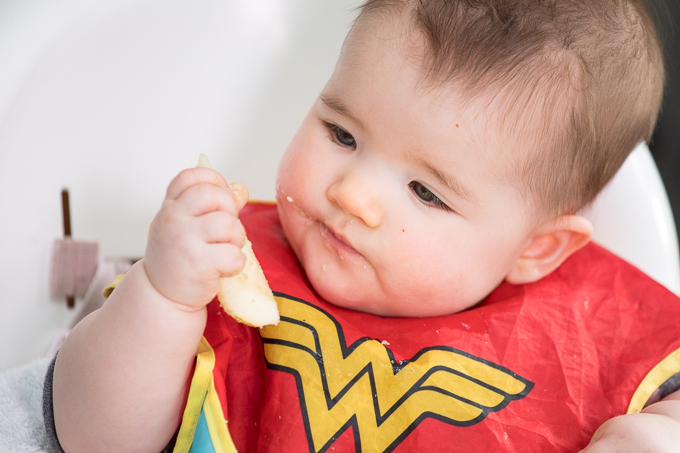
Bananas are a delicious and easy food to offer your baby when they are ready to start solids. A yummy, economic, and versatile option, it is hard to go wrong! Bananas are sweet and soft, a great texture for learning to chew. As your kiddo’s little gums mash chunks of ripe banana, they are also strengthening their chewing and oral motor muscles!
Here is what this post will cover:
- When to introduce bananas to baby
- Why bananas are great baby-led weaning food
- Health benefits of banana
- Is there a difference between organic or conventional bananas?
- How to serve banana to baby
- How to store bananas for baby-led weaning
- Ripe bananas versus unripe bananas
- Frequently asked questions about introducing banana to your baby
- Quick balanced banana snack combinations
- Delicious baby-led weaning banana recipes
Need personalized nutrition support?
Book an appointment with one of our pediatric dietitians today!
When to Introduce Baby-Led Weaning with Banana
You can serve bananas to your baby as soon are they are showing all the signs of readiness to eat solids! For most babies this happens at around 6 months – this is right around the time that I recommend introducing solid foods. Check out this guide for important information on your baby’s readiness cues for baby-led weaning.
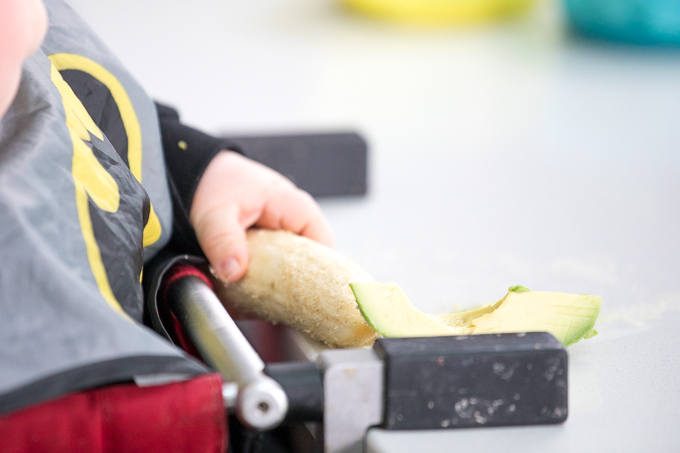

Starting solids? Don’t panic.
Starting solids is an exciting milestone in your baby’s life, but it can also be confusing, especially when you’re overloaded with conflicting information on how and when to do it. Download your free guide to starting solids and clear the confusion!
Why bananas are a great baby-led weaning food
Not only are bananas scrumptious and sweet, they are also the perfect soft texture for baby led weaning, without any modification needed! A peeled ripe banana is firm enough for your baby to grasp and bring to the mouth, but soft enough to easily mash between their gums. Bananas also can be easily manipulated to your baby’s preferred texture. If your baby prefers eating from a spoon, simply mash the banana in a bowl with a fork! Bananas on their own have many health benefits (as outlined below), however they can be easily combined with other foods to amp up the nutrition of your baby’s meal even more! Mix mashed bananas into high iron infant oatmeal or whole plain yogurt, a good source of protein and calcium!
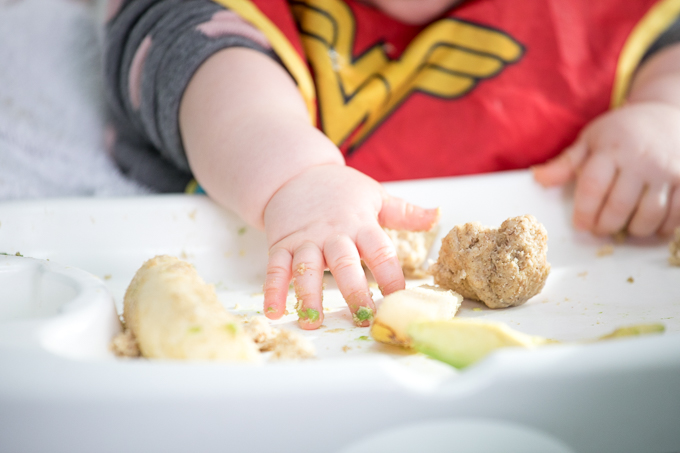
The versatility of bananas makes them an ideal baby led weaning food. Since this yellow fruit can be changed into so many different textures and forms, there is great opportunity for your baby to be exposed to its flavor in many ways! Let your baby touch, squish, taste and experiment with what you offer. They get to lead the way! You may find that your baby prefers banana puree one day, but a few exposures down the line, they may seem to love banana fingers (see examples below)!
Health Benefits of Banana
Bananas are a source of carbohydrate, which provides energy for your baby to develop, move and grow. They are also a good source of fibre, which helps aid digestion and promote a healthy gut. This yellow and naturally sweet fruit is also an excellent source of certain essential vitamins and minerals including vitamin B6, potassium and magnesium. Both potassium and magnesium are needed for proper nerve and muscle function in your baby. Magnesium also plays a part in building strong bones too!
One small banana provides more than enough of the vitamin B6 your baby needs in a day. This B vitamin is essential for your baby’s cognitive development and immune function.
Is There a Difference Between Organic or Conventional Bananas?

As a dietitian I get asked this question all of the time! The main difference between organic and conventional bananas is the way they were grown. Canadian Organic Standards do not allow the use of synthetic fertilizers or pesticides, and encourage practices that promote biodiversity and reduce environmental impacts1. These regulations make organic bananas more expensive than conventional bananas. However, both conventional and organic bananas are equal in nutritional value and offer the same health benefits! Really, it comes down to personal preference.
How to Serve Banana to Baby
6-7 months
Banana fingers

Split banana by running your finger through the top point down the middle seem, so that it comes apart in 3 long finger-like strips. The banana will be less slippery when separated this way allowing your baby to get a better grasp to bring it up to their mouth.
Banana with bottom skin on

Cut a large banana in half. Take one half of the banana and carefully cut into the peel horizontally about halfway down. Slice into the banana just enough to cut the peel, but not into the flesh. Cut around the diameter and pull off the top section of peel. This will leave the bottom half of the banana covered in peel so your baby has a “handle” to easily grasp and bite/gum the top exposed banana flesh.
Banana mash

Peel a ripe banana and mash with a fork on a plate or in a bowl. Mash to varying levels of consistency to expose your baby to different textures (i.e. smooth, lump, or chunky). Your baby can use a self-feeding spoon like this one by Grabease or this infant spoon by Munchkin.
8-9 months
Strips of banana rolled in hemp hearts or infant cereal

Separate banana into strips with fingers or knife. Roll banana in hemp hearts or infant cereal. This allows your baby to grip the banana better as it will be less slippery.
Banana pancakes
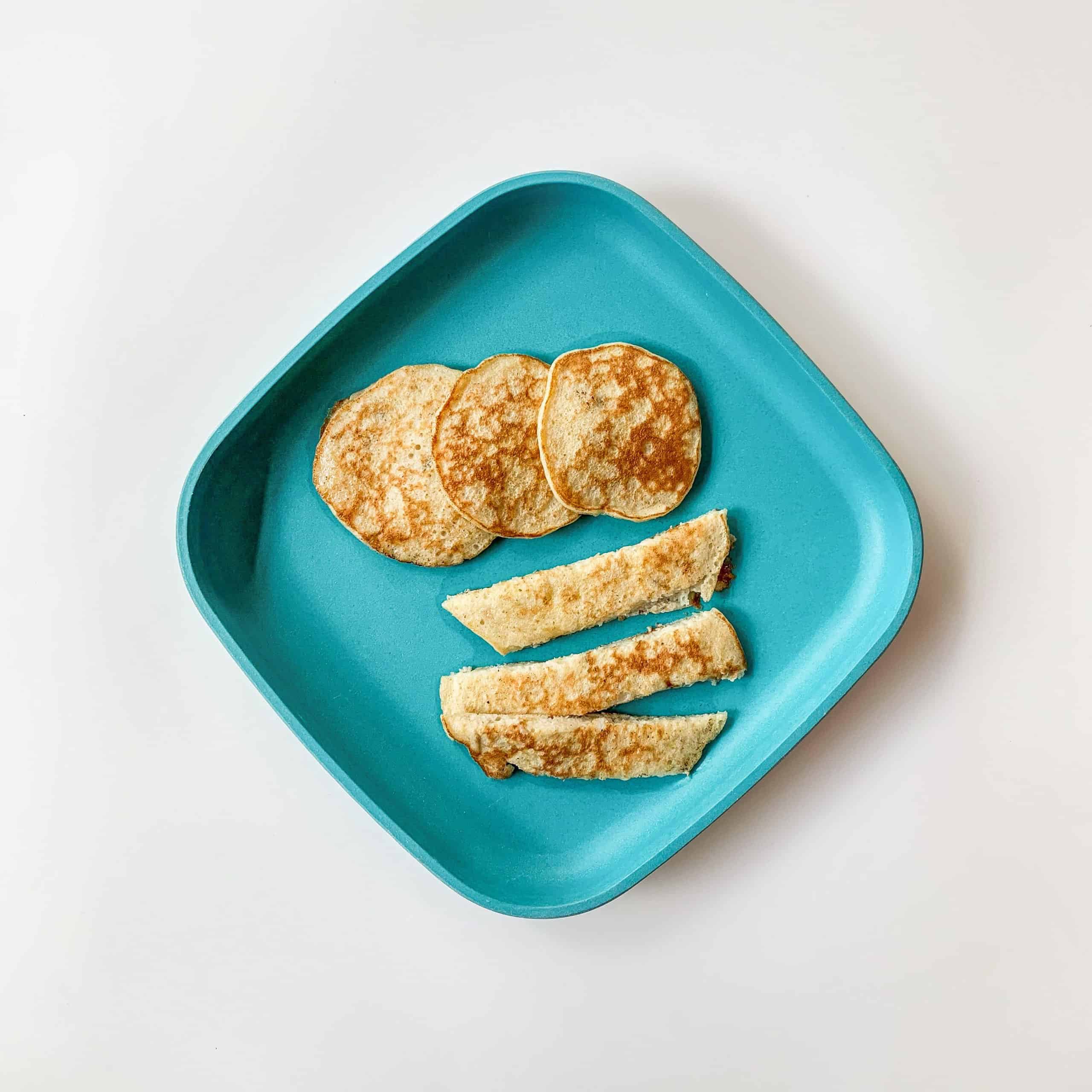
Mash a banana with a fork and whisk in 2 eggs. Add in about ¼ cup of baby oatmeal to get a pancake batter consistency. Ladle mixture onto an oiled non-stick pan and cook pancakes. Serve cooled mini pancakes, or cut larger pancakes into fingerlike strips for an easy grasp. Also it is an option to cut into medium sized pieces to encourage pincer grasp.
Banana yogurt popsicles

Blend frozen banana with milk, plain yogurt. Option to add other spices or fruits such as cinnamon, or strawberries! Pour smoothie mixture into popsicle molds and allow them to freeze in the freezer. Serving banana in popsicle form exposes your baby to the banana flavor at a different temperature and texture to help expand their palate. What a delicious way to start baby-led weaning with banana!
10-12 months
Banana oatmeal

Mash banana and stir it into your baby’s favorite cooked oatmeal combination to add additional sweetness and nutrition!
Banana chunks in yogurt

Cut up banana into smaller bite sized chunks and mix it into plain yogurt. Managing two different textures mixed together helps baby to strengthen their ability to manipulate, chew, and swallow more complex combinations of food.
Sliced banana on nut butter toast

Spread a thin layer of peanut butter on whole grain toast. Layer with thin slices of banana over top. This is a great way to add natural sweetness and variety to your baby’s toast!
How to store bananas for baby-led weaning
Storing whole bananas
Buy green bananas if you want maximum storage time before they ripen. If you plan to eat your bananas throughout the week it’s a good idea to buy bananas in varying degrees of ripeness. When ripe yellow bananas become speckled with a few brown spots, they become quite sweet, soft and easy to peel. This is the perfect stage for mashing into baked goods, or freezing for later use in banana smoothies or other recipes. Be sure to always peel your bananas before freezing them. If you plan on blending the frozen bananas later, it’s a good idea to slice them into smaller round pieces, making the frozen flesh easier to blend into a smooth creamy texture.

Storing pureed banana
Store fresh pureed banana baby food in a sealed container in the fridge for up to 2 days or in the freezer for up to 1 month2. Throw out baby led weaning type strips or chunks of banana after your baby is done. Throw away left over banana puree, do not store in fridge for later use as it will be contaminated with your baby’s saliva.
Storing your bananas in the refrigerator will actually cause the peel to turn a brown or black color as the cold damages the cells in the banana peel. However even though the peel looks like the banana is over-ripe, the actual banana flesh will ripen more slowly in cold temperatures.
Ripe Bananas Versus Unripe Bananas

Have you ever wondered why yellow, more ripe bananas taste much sweeter than the unripe green ones? This is because as the banana ripens, the resistant starch is converted into simpler more digestible sugars. This also makes the banana flesh softer and sweeter, with less of a “starchy” taste.
If you want your bananas to ripen faster, store them at room temperature beside other ripe fruits or bananas. Ripe fruits produce a gas that accelerates the ripening process! Storing bananas in a paper bag can also help trap this gas and make the banana ripen faster.
If you want to delay bananas from ripening so they last longer, ensure to remove them from any bags, so the ripening gas can escape. Avoid choosing already spotted or bruised bananas as this means it has more air exposure which makes it ripen faster. If you wrap the stems of your banana bunch with plastic wrap, it will help to decrease oxygen exposure, slowing the ripening process.
Frequently asked questions about introducing banana to your baby
Constipation can be the result of one or more of the following: not enough dietary fibre, low fluid intake, or not moving their bodies enough. On the other hand, too much fibre paired with not drinking enough fluid can also lead to constipation! As you can see the answer is not simple. What we do know is that bananas are a good source of both soluble and insoluble fibre. Soluble fibre attracts water and forms a gel to help create bulk to help regulate digestion. Insoluble fibre passes through the digestive system unchanged, helping to “push things along” and promote healthy bowel movements. Bananas generally help promote regular bowel movements in babies because its is a good source of both of these fibres. However, as mentioned above, too much fibre (or too much banana) can plug up the digestive system when not in balance with enough movement or fluid intake.
Ripe bananas are not a typical choking hazard for babies as they are soft and easy to breakdown in the mouth. Make sure to serve ripe bananas with a deep yellow color and a few brown spots to ensure the texture is soft but not too mushy. Overripe brown bananas are too squishy for a baby to pick up and bring to their mouth for self-feeding purposes. Unripe green bananas are too firm and more difficult for your little one to chew down and swallow, posing a possible choking risk. The simplest and safest way is to serve your baby ripe soft bananas in strips/chunks or mashed/ pureed form.
Quick Balanced Banana Snack Combinations
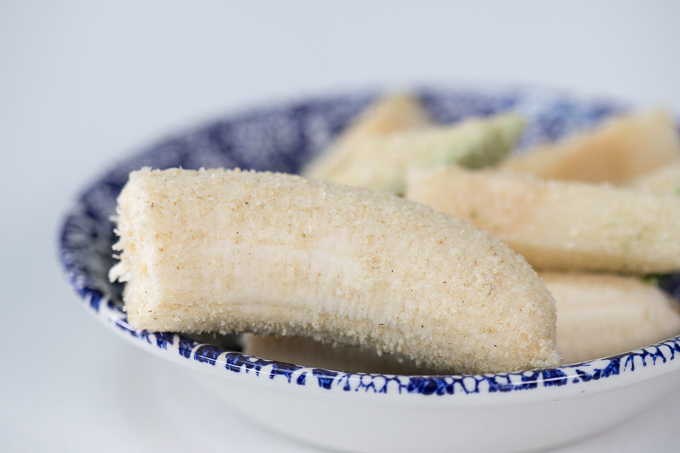
Pairing banana with a protein containing food is a great way to amp up the nutrients of your little one’s snack, while providing essential building blocks for your baby’s growth and development. Protein will also help to fill up their little tummies until the next scheduled feeding! Here are some quick and easy snacks for baby-led weaning with banana:
- Banana mash or chunks mixed into plain full fat yogurt
- Banana strips and nut butter dip (made from plain yogurt and nut butter mixed)
- Banana chunks and shredded cheese
- Banana strips or chunks rolled in hemp hearts
- Peanut butter toast with thinly sliced banana on top
- Banana smoothie with frozen banana, milk, plain yogurt, peanut butter, and cocoa powder (optional)
Delicious recipes for baby-led weaning with banana
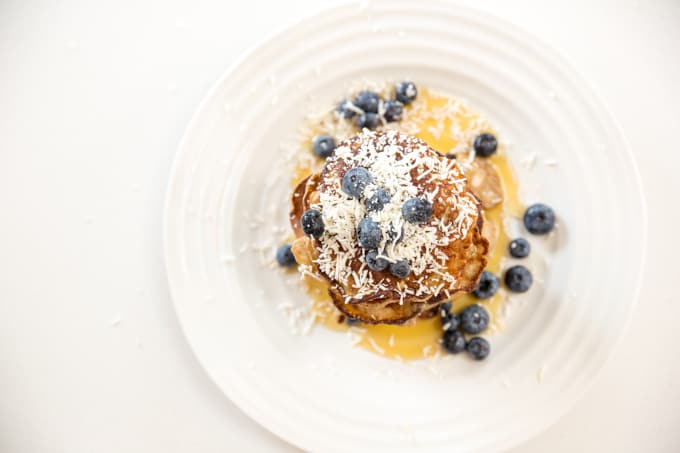
- Iron-Rich Mini Banana Muffins for Baby Led Weaning
- 3-Ingredient Flourless Banana Pancakes
- Easy Peanut Butter Banana Fudgesicles
- Mango Banana Coconut Smoothie
- Easy Egg and Banana Mini Muffins
References:
- FAQ | Choose Canada Organic
- Infant Nutrition – Complementary Feeding – Key Practice Points (pennutrition.com)

This post was written by Susan Sommerville, RD and reviewed by Sarah Remmer, RD
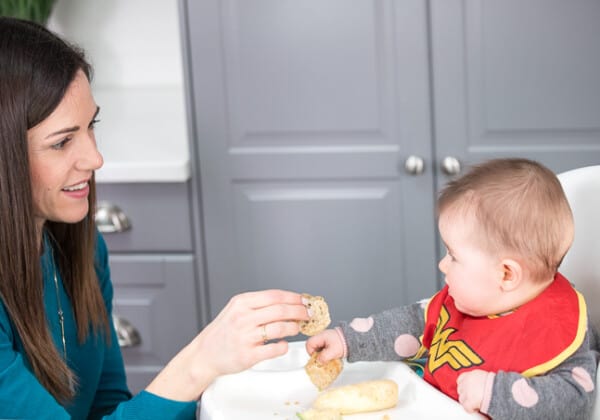


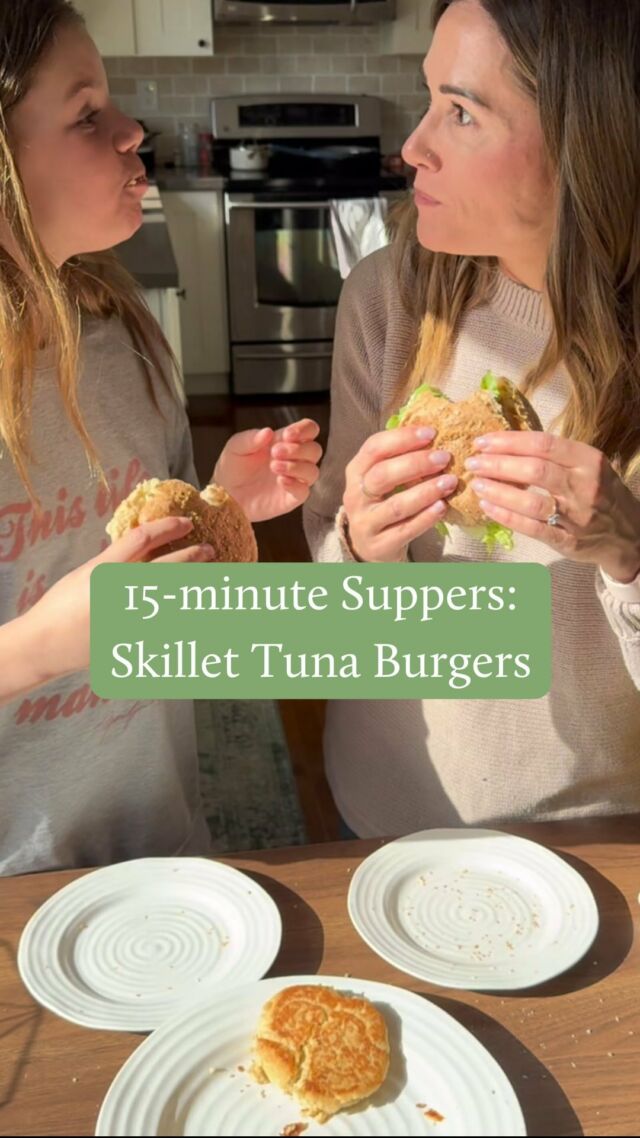
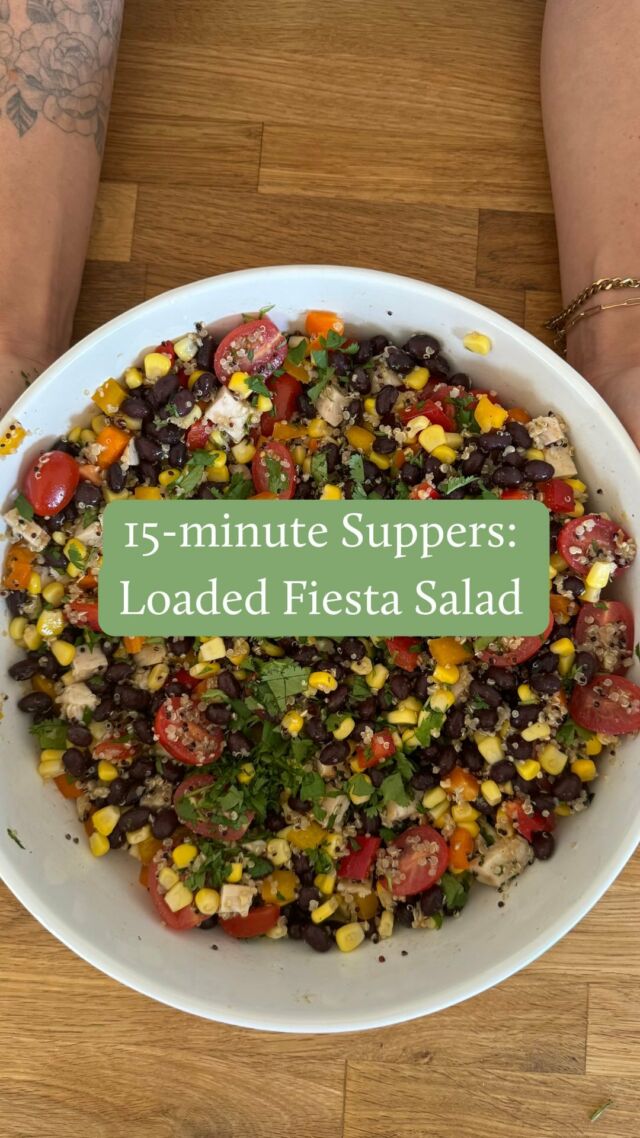



Leave a Comment